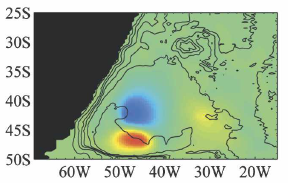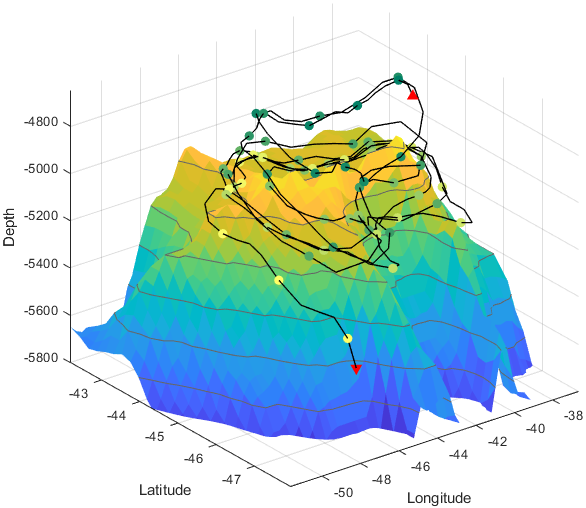Argentine Basin
Altimeter observations analyzed by Fu et al. (2001) shows a very pronounced mode of variability in the Argentine Basin: a dipole in sea-surface height appears to rotate around a seamount -called Zapiola Rise- every 25 days. Bottom pressure measurements by Hughes et al. (2007) confirm the presence of strong barotropic oscillations, but at a period of only 19.6 days.

In Weijer et al. (2007a) we show that this discrepancy can be explained by the presence of multiple oscillatory modes. Two statistical techniques (POP and CEOF analysis), applied to 10 years of altimeter data, show several distinct statistical modes; one matches the Fu et al. (2001) observations, another those of Hughes et al. (2007). As a matter of fact, we identified a whole spectrum of modes in a shallow-water model of the Argentine Basin. The dominant mode with a period of 19.6 days clearly corresponds to the Hughes et al. (2007) oscillation. However, the mode displaying the clearest similarities (in spatial structure) with the Fu et al. (2001) observations shows up with a period of 31.5 days.

In Weijer et al. (2007b) we used a continuation method to link the spectrum of modes of the Argentine Basin to the Rossby basin modes in the flat, rectangular basin of classical theory. To this end, we defined a gradual transformation that morphed the full-bathymetry domain into a rectangular basin; and although in reality the modes are strongly controlled by bathymetry, (almost) each of them could be linked to a distinct classical Rossby basin mode.
I am also interested in the sediment transport in the Argentine Basin to understand the controls on the existence and growth Zapiola Rise. In Weijer et al. (2015) we used passive tracers in an eddy-resolving ocean model to study whether sediment transport by the strongly turbulent circulation in the Argentine Basin can account for enhanced deposition over the Zapiola Rise. However, we found that the Zapiola Anticyclone is a barrier for sediment transport, leaving the Zapiola Rise as a sediment-starved region. Other processes, like resuspension, are probably critical to resolve this mystery.
In Weijer et al. (2020), we studied the vertical motions within the Zapiola Anticyclone. We used a Lagrangian method to track water parcels while they were being advected in a flow field from an eddy-permitting ocean model. In particular, we found that the secondary dynamics of the Zapiola Anticyclone pumps roughly 2 Sv into the bottom boundary layer, The picture that emerges is one of water parcels spiraling downward through the water column, undergoing downwelling while they revolve anticyclonically around the center of the ZA. In our experiment, water parcels spend on average 451 days within the ZA, and make 2.6 revolutions around its center, with each revolution taking somewhere between 100 and 200 days. On average, parcels undergo a 94 m descent, 0.03C cooling and 0.0042 psu freshening. But individual parcels can undergo more than 800 m of downwelling, 0.2C of cooling, and 0.02 psu of salinity change.
References
- Fu et al. 2001: 25-Day Period Large-Scale Oscillations in the Argentine Basin Revealed by the TOPEX/Poseidon Altimeter. J. Phys. Oceanogr., 31, 506-517, doi: 10.1175/1520-0485(2001)031<0506:dplsoi>2.0.co;2
- Hughes et al. 2007: Three forms of variability in Argentine Basin ocean bottom pressure. J. Geophys. Res., 112, C01011; doi: 10.1029/2006JC003679.
- Weijer et al. 2007: Multiple oscillatory modes of the Argentine Basin. Part I: Statistical analysis. J. Phys. Oceanogr., 37, 2855-2868, doi: 10.1175/2007jpo3527.1.
- Weijer et al. 2007: Multiple oscillatory modes of the Argentine Basin. Part II: The spectral origin of basin modes. J. Phys. Oceanogr., 37, 2869-2881, doi: 10.1175/2007jpo3688.1.
- Weijer et al. 2015: Eddy-driven sediment transport in the Argentine Basin: is the height of the Zapiola Rise hydrodynamically controlled? J. Geophys. Res., 120, doi: 10.1002/2014JC010573.
- Weijer et al. 2021: The Zapiola Anticyclone: A Lagrangian Study of its Kinematics in an Eddy-Permitting Ocean Model. Deep-Sea Res. I: Oceanogr. Res. Pap., 164, 103308, doi:10.1016/j.dsr.2020.103308.


